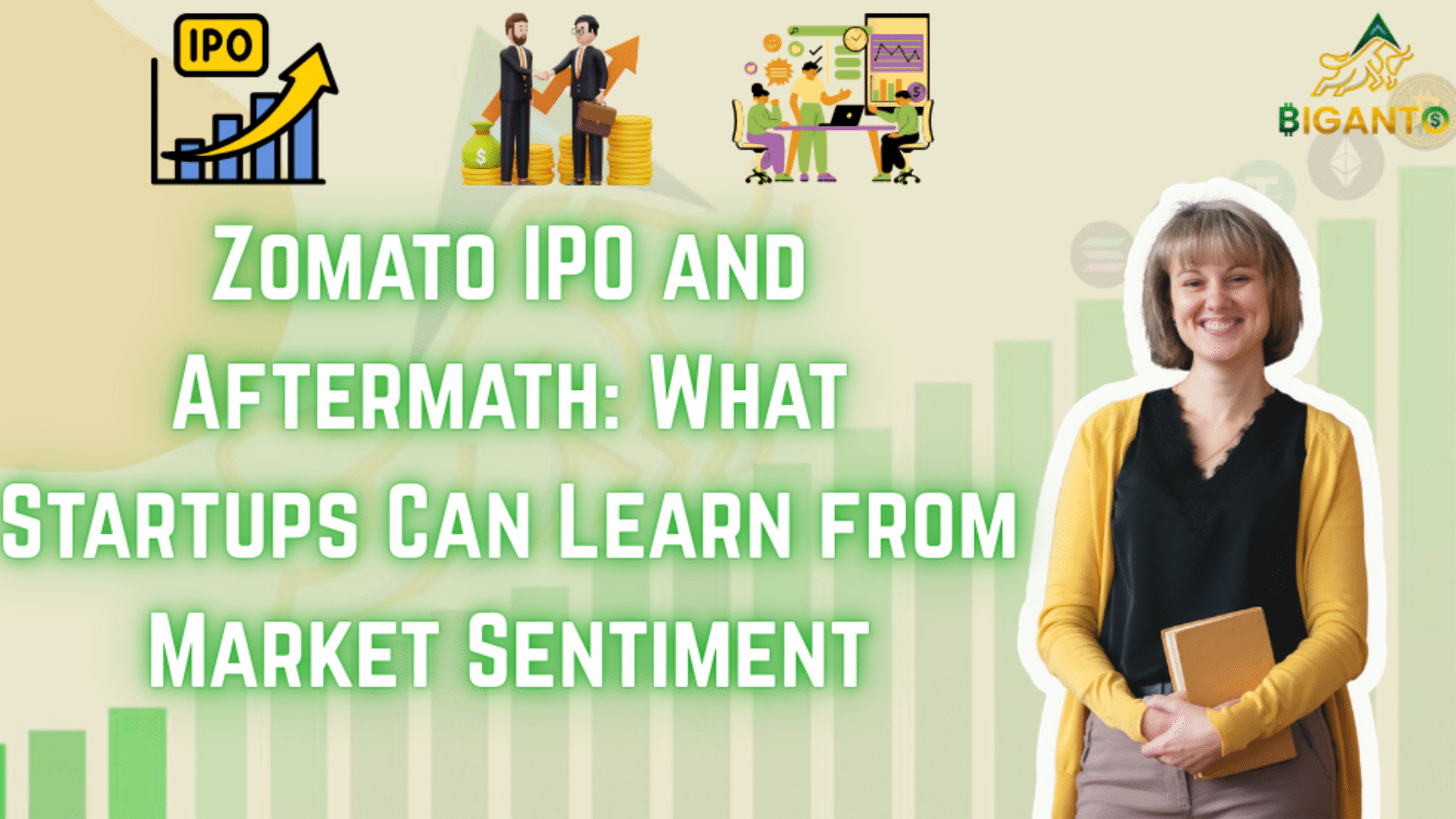Zomato made a historic moment in India’s startup ecosystem, it came as a first major tech unicorns to go public in 2021. Zomato’s IPO gained investors intrest because it was a well know startup. IPO was oversubscribed.But after some time stock price went down investors opinion change and market sentiment went down. Zomato IPO teach why earning investor trust, having a strong business plan, and being ready for ups and downs.
Introduction: New Journey
Zomato known for the food delivery giant. It began as an online restaurant directory called ‘Foodiebay.’ After successfully operating in major Indian cities, this on-demand food delivery app expanded its operations internationally in 2014. In July 2021, Zomato IPO launchand it was described as a “unique and first-of-its-kind listing” in the Indian market, generating considerable excitement. At one point, Zomato was struggling so much that it was ready to go public (IPO) at a much lower valuation — just $500 million, which was a big drop from its earlier $4 billion value. But things started to change when the first wave of the pandemic ended. It become like trend to order online food, and Zomato’s business picked up again.
This helped the company launch a successful IPO in July 2021. The public response was huge — the IPO was subscribed 38 times, and on the first day of trading, Zomato’s stock opened 66% higher than the issue price.
Zomato’s IPO Valuation: A Closer Look
Before its IPO, Zomato was still going through tough financial times. The company had reported a loss of ₹490 crore and a negative operating cash flow of over ₹1,000 crore — which was not a good sign for investors. Its revenue dropped by 23% to $283 million for the financial year ending March 2021. Although losses reduced by 66% to $110 million compared to the previous year, the year overall was a difficult one for Zomato.
Yet, despite these challenges, Zomato showed strong momentum just months before the IPO. According to its filings with SEBI, in the three months after filing the draft red herring prospectus (DRHP), Zomato increased its IPO offer size by ₹1,500 crore and added ₹15,000 crore to its overall valuation — showing improving investor confidence.
Key details from the 420-page DRHP document:
Total IPO Size: ₹9,375 crore
Fresh issue: ₹9,000 crore
Offer for sale (OFS): ₹375 crore (by early investor Info Edge)
Price Band: ₹72–₹76 per equity share
IPO Allotment Structure:
75% reserved for Qualified Institutional Buyers (QIBs)
10% reserved for Retail Investors
15% for Non-Institutional Investors (NIIs)
Post-IPO Effect
1. Reality Check
When hype fades, then reality hits. Investors began to doubt Zomato’s future prospects due to its financial losses. That’s the fact that the IPO was huge, but it faded when investors shifted their interest.
2. Global Crisis Hits Sentiment
In early 2022, global tensions spiked when Russia invaded Ukraine. Globally market panic in global financial markets, and foreign investors began withdrawing money from Indian stocks. Zomato, like many other tech stocks, was impacted by this sudden drop in market confidence.
3. Blinkit Acquisition Raises Eyebrows
Zomato announced a complete acquisition of Blinkit, a quick-commerce grocery delivery startup it had previously invested in. While the logic was based on the fast growth of the quick commerce sector — expected to reach ₹20,400 crore by FY25 and ₹60,300 crore by FY30 — many investors saw this move as risky. They were already concerned about Zomato’s cash burn, and the Blinkit deal added to those fears.
4. Major investors lost
Tiger Global and Sequoia Capital were the big investors of Zomato. When they sold their half stocks, which is around 5% of Zomato stock. Stock price went down, and investors got panicked.
5. Right Valuation
Zomato entered the market with overvaluation. When the global market went down, the price fell down and came to its right value.
Zomato Stock Performance—Rise, Fall, and Recovery
Initial Boom
After listing at ₹76 in July 2021, Zomato’s stock surged to an all-time high of ₹160.3 by November 2021. This was driven by optimism around tech IPOs and strong investor interest.
Sharp Decline
But the rally didn’t last long. By July 2022, the stock hit a low of ₹46.80, a 74% drop from its peak. Reasons included ongoing losses, market corrections, and fear around high valuations.
Recovery Begins
From January 2023, the stock began recovering steadily. By October 2024, it had given a 130% return over the past year, and as of July 7, 2025, the share price reached ₹261, marking a 243% gain since IPO.
Zomato Stock Performance (July 2021–July 2025)
IPO Price | ₹76
Listing Date | July 23, 2021
Peak Price | ₹160.3 (Nov 2021)
Trough Price | ₹46.80 (July 2022)
Recent Price | ₹261 (July 7, 2025)
Overall Return Since IPO | 243%
What Startups Can Learn from the Zomato IPO
1. Market readiness
Zomato’s IPO success was a good sign that the Indian market was ready for tech startup IPOs. After Zomato’s successful IPO, some more startups came with IPOs, like Nykaa. Nykaa has shown robust performance in its beauty and fashion verticals, consistently reporting double-digit growth. Policybazaar Listed in 2021 at an IPO price of Rs 980, its current market price is Rs 1,794, delivering an 83% return since its IPO.
The mixed performance of tech IPOs like Zomato, Policybazaar, Paytm, and Delhivery highlights a crucial lesson: hype may drive a strong debut, but long-term success depends on solid fundamentals. While Zomato and Policybazaar delivered positive returns, Paytm struggled due to its lack of a clear moat and overvaluation. This proves that public markets eventually shift focus from growth stories to profitability, competitive edge, and sustainable business models. For startups, chasing high IPO valuations alone is risky—building a resilient, well-structured business is what truly sustains value in the long run.
2. Market Sentiment
Zomato’s IPO gets too much hype due to first startup IPO. Startup made the history by coming in stock market. But when the hype got fade than reality of the market becomes clear that the market focused on cash flows, profits, and sustainable growth not just with popularity. Startups must remember hype can take you public, but only performance can keep you there.
3. Timing: The firm went public at a time when investor sentiment regarding tech companies was bullish. The Zomato IPO comes at the perfect time, which gives it huge popularity and huge subscription.
4. Discipline
Zomato’s 74% stock drop after its peak and Paytm’s post-IPO struggles show the risks of chasing unrealistic, high valuations. An IPO should be a step toward building the future—not just a cash-out for early investors. Overpricing can hurt long-term investor trust, stock performance, and future funding chances.
5. Diversification
Zomato’s expansion into quick commerce (Blinkit), B2B supplies (Hyperpure), and events (District) shows its ambition to build a broader digital consumption ecosystem. Diversification can help startups grow their market and customer base, but it also brings challenges like cash burn, complexity, and thinner margins. That’s why it’s important to only enter new segments that align with the company’s strengths and strategy.
Startups should clearly explain their long-term vision to investors, including how and when each new business line will become profitable. Jumping into multiple areas without a focused plan or competitive edge can backfire.
Final Thoughts
Zomato’s IPO marked a major milestone for Indian startups, but its journey also showed the harsh realities of public markets. Early hype pushed the stock up, but weak financials, risky moves like the Blinkit deal, and changing market sentiment led to a sharp fall.
However, Zomato made a strong comeback by focusing on profitability, efficiency, and strategic growth. The key lesson for startups: Hype can take you public, but only strong fundamentals can sustain you.
Go public with a clear plan, realistic valuation, and long-term vision — because in the public markets, performance matters more than promises.

